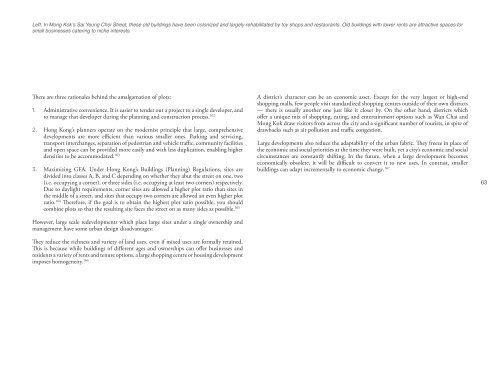Treating the Symptoms - A Critical Review of ... - Civic Exchange
Treating the Symptoms - A Critical Review of ... - Civic Exchange
Treating the Symptoms - A Critical Review of ... - Civic Exchange
- No tags were found...
You also want an ePaper? Increase the reach of your titles
YUMPU automatically turns print PDFs into web optimized ePapers that Google loves.
Left: In Mong Kok’s Sai Yeung Choi Street, <strong>the</strong>se old buildings have been colonized and largely rehabilitated by toy shops and restaurants. Old buildings with lower rents are attractive spaces forsmall businesses catering to niche interests.There are three rationales behind <strong>the</strong> amalgamation <strong>of</strong> plots:1. Administrative convenience. It is easier to tender out a project to a single developer, andto manage that developer during <strong>the</strong> planning and construction process. 1622.3.Hong Kong’s planners operate on <strong>the</strong> modernist principle that large, comprehensivedevelopments are more efficient than various smaller ones. Parking and servicing,transport interchanges, separation <strong>of</strong> pedestrian and vehicle traffic, community facilitiesand open space can be provided more easily and with less duplication, enabling higherdensities to be accommodated. 163Maximizing GFA. Under Hong Kong’s Buildings (Planning) Regulations, sites aredivided into classes A, B, and C depending on whe<strong>the</strong>r <strong>the</strong>y abut <strong>the</strong> street on one, two(i.e. occupying a corner), or three sides (i.e. occupying at least two corners) respectively.Due to daylight requirements, corner sites are allowed a higher plot ratio than sites in<strong>the</strong> middle <strong>of</strong> a street, and sites that occupy two corners are allowed an even higher plotratio. 164 Therefore, if <strong>the</strong> goal is to obtain <strong>the</strong> highest plot ratio possible, you shouldcombine plots so that <strong>the</strong> resulting site faces <strong>the</strong> street on as many sides as possible. 165However, large scale redevelopments which place large sites under a single ownership andmanagement have some urban design disadvantages:They reduce <strong>the</strong> richness and variety <strong>of</strong> land uses, even if mixed uses are formally retained.This is because while buildings <strong>of</strong> different ages and ownerships can <strong>of</strong>fer businesses andresidents a variety <strong>of</strong> rents and tenure options, a large shopping centre or housing developmentimposes homogeneity. 166A district’s character can be an economic asset. Except for <strong>the</strong> very largest or high-endshopping malls, few people visit standardized shopping centres outside <strong>of</strong> <strong>the</strong>ir own districts— <strong>the</strong>re is usually ano<strong>the</strong>r one just like it closer by. On <strong>the</strong> o<strong>the</strong>r hand, districts which<strong>of</strong>fer a unique mix <strong>of</strong> shopping, eating, and entertainment options such as Wan Chai andMong Kok draw visitors from across <strong>the</strong> city and a significant number <strong>of</strong> tourists, in spite <strong>of</strong>drawbacks such as air pollution and traffic congestion.Large developments also reduce <strong>the</strong> adaptability <strong>of</strong> <strong>the</strong> urban fabric. They freeze in place <strong>of</strong><strong>the</strong> economic and social priorities at <strong>the</strong> time <strong>the</strong>y were built, yet a city’s economic and socialcircumstances are constantly shifting. In <strong>the</strong> future, when a large development becomeseconomically obsolete, it will be difficult to convert it to new uses. In contrast, smallerbuildings can adapt incrementally to economic change. 16763
















